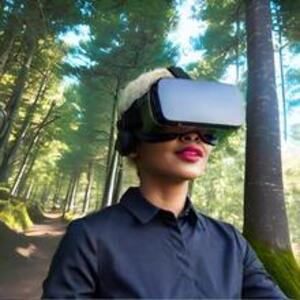Launching late March 2024
Research has repeatedly demonstrated that spending time in nature can positively impact our personal wellbeing. While we don’t always have easy access to natural spaces, recent research is demonstrating that even encountering nature using immersive virtual reality can have similar positive effects! These effects include facilitating recovery of depleted emotional capacity and even boosting creativity. In a 2022 study, workers in a high stress work environment who took a short nature break (less than 30 minutes) using the Nature Treks VR app, reported significantly increased feelings of happiness and relaxation, as well as significantly decreased feelings of sadness, anger, and anxiety. The experience was also associated with a significant reduction in heart rate.
The Conflict Management and Human Rights Office (CMAHRO), with support from the Staff Enhancement Fund (SEF), is bringing these benefits to UW staff with the VR for Workplace Wellness initiative. This initiative has placed three Meta Quest 2 head-mounted displays (HMDs) in each of the Dana Porter and Davis Center libraries. The headsets have been preloaded with the Nature Treks VR app and are available for all University of Waterloo staff (part-time, full-time, casual, and student staff) to sign out for one-hour intervals at the circulation desk. Nature Treks VR allows you to explore a wide variety of natural settings including tropical beaches, green fields, underwater oceans, and outer space. Within these spaces you can interact with more than 60 different animals, and change the weather and time of day.
For more information about how to use the headsets, review the “Getting Started” resources below. Questions can be directed to Lynn Long (l3long@waterloo.ca), Senior Education Specialist in the Conflict Management and Human Rights Office. Thanks to Lynn Long and Gillian Dabrowski for their work setting up this program!
Getting started
If you haven’t used a Meta Quest 2 before or need a refresher, these links have been selected/created to help you get up and running as quickly as possible.
Using the Meta Quest 2 headsets
Instructions and video to help you get started with the Meta Quest 2 headsets, including how to:
- Power on/off
- Connect to wifi
- Adjust your headset
- Set up a safety boundary
- Use the hand controls
References
Adhyaru, J. S., & Kemp, C. (2022). Virtual reality as a tool to promote wellbeing in the workplace. Digital Health, 8, 205520762210844. https://doi.org/10.1177/20552076221084473
Antonelli, M., Donelli, D., Carlone, L., Maggini, V., Firenzuoli, F., & Bedeschi, E. (2022). Effects of forest bathing (shinrin-yoku) on individual well-being: An umbrella review. International Journal of Environmental Health Research, 32(8), 1842-1867.
Browning, M. H., Mimnaugh, K. J., Van Riper, C. J., Laurent, H. K., & LaValle, S. M. (2020). Can simulated nature support mental health? Comparing short, single-doses of 360-degree nature videos in virtual reality with the outdoors. Frontiers in psychology, 10, 2667.
Karacan, B., Kombeiz, O., & Steidle, A. (2021). Powered by virtual realities: promoting emotional recovery through technology-based recovery interventions. Ergonomics, 64(10), 1351-1366.
Palanica, A., Lyons, A., Cooper, M., Lee, A., & Fossat, Y. (2019). A comparison of nature and urban environments on creative thinking across different levels of reality. Journal of Environmental Psychology, 63, 44-51.
 Launching late March 2024
Launching late March 2024



